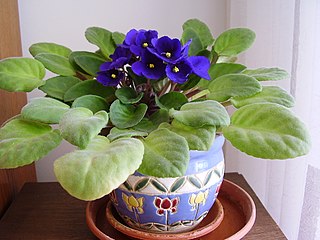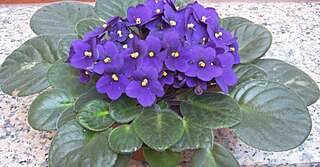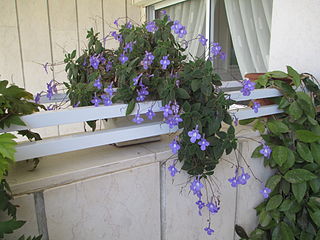
Gesneriaceae, the gesneriad family, is a family of flowering plants consisting of about 152 genera and ca. 3,540 species in the tropics and subtropics of the Old World and the New World, with a very small number extending to temperate areas. Many species have colorful and showy flowers and are cultivated as ornamental plants.
The African Violet Society of America (AVSA) is an international society of plant enthusiasts who promote the cultivation of African violets as house plants. The Society hosts an annual convention and publishes a bi-monthly full-color 64-page magazine, the African Violet Magazine.

Streptocarpus is an Afrotropical genus of flowering plants in the family Gesneriaceae. The genus is native to Afromontane biotopes from central, eastern and southern Africa, including Madagascar and the Comoro Islands. The flowers are five-petalled, salverform tubes, almost orchid-like in appearance, and hover or arch over the plant, while the pointed, elongate fruit is of a helical form similar to that of the "tusk" of a narwhal. In the wild, species can be found growing on shaded rocky hillsides or cliffs, on the ground, in rock crevices, and almost anywhere the seed can germinate and grow. For the home, there are now many hybrids of various colours and forms available.

Streptocarpus sect. Saintpaulia is a section within Streptocarpus subgenus Streptocarpella consisting of about ten species of herbaceous perennial flowering plants in the family Gesneriaceae, native to Tanzania and adjacent southeastern Kenya in eastern tropical Africa. The section was previously treated as a separate genus, Saintpaulia, but molecular phylogenetic studies showed that it was nested within the genus Streptocarpus.

The Eastern Arc Mountains are a chain of mountains found in Kenya and Tanzania. The chain runs from northeast to southwest, with the Taita Hills being in Kenya and the other ranges being in Tanzania. They are delimited on the southwest by the fault complex represented by the Makambako Gap that separates them from the Kipengere Range. To the northeast, they are delimited by more recent volcanism represented by Mount Kilimanjaro. The chain is considered a tentative World Heritage Site.
Streptocarpus inconspicuus, synonym Saintpaulia inconspicua, is a species of Streptocarpus in the section Saintpaulia. It is a rare African violet, found in the Uluguru Mountains in Tanzania, East Africa. It was first formally described in 1958. It is classed as an endangered species by the IUCN Red List.

The Botanischer Garten der Technischen Universität Dresden, also known as the Botanischer Garten Dresden or Dresden Botanical Garden, is a botanical garden maintained by the Dresden University of Technology. It is located in the north-west section of the Großer Garten at Stübelallee 2, Dresden, Saxony, Germany. It is open daily without charge.

Streptocarpus rexii is a South African plant in the family Gesneriaceae, occurring widely from the southern Cape along the coastal hills, mountains, wooded ravines and valleys, and moist forests of the east coast, through Natal as far north as the Eastern Transvaal, up to an elevation of about 900 m. This genus of epiphytes and lithophytes, of about 130 species, is mainly African and Mascarene, with four vagrant species in Asia. Streptocarpus, as do other Old World Gesneriaceae, is unusual in that it displays anisocotylous or unequal growth, i.e. one cotyledon continues to grow after germination.

Streptocarpus teitensis, synonym Saintpaulia teitensis, is a species of Streptocarpus in the section Saintpaulia. It is endemic to 1 square kilometer on Mbololo Hill in the Taita Hills of southern Kenya. The total population is estimated at less than 2,500 individual plants in the wild.

Streptocarpus shumensis, synonym Saintpaulia shumensis, is a species of Streptocarpus in the section Saintpaulia. It is endemic to Shume in the west Usambara Mountains and also from the northern Nguru Mountains, both in Tanzania, where it grows at elevations of 1,300 to 2,000 meters above sea level.

The Didymocarpoideae are a subfamily of plants in the family Gesneriaceae. It was formerly the subfamily Cyrtandroideae. This subfamily consists mostly of tropical and subtropical Old World genera, found in Africa, Asia and the Pacific. One species is native to Central and South America.

Streptocarpus ionanthus is a species of Streptocarpus in the section Saintpaulia, commonly known as an African violet. It is native to eastern and southwestern Tanzania.
Streptocarpus afroviola, synonym Saintpaulia pusilla, is a species of flowering plant in the family Gesneriaceae, native to Tanzania. It was first described in 1900 by Adolf Engler as Saintpaulia pusilla. The former genus Saintpaulia was reduced to Streptocarpus sect. Saintpaulia, and the species was moved to Streptocarpus. However, the name Streptocarpus pusillus had been used in 1883 for a different species, so Maarten J. M. Christenhusz put forward the replacement name Streptocarpus afroviola.
Streptocarpus albus is a species of flowering plant in the family Gesneriaceae, native to Tanzania. It was first described in 1933 as Saintpaulia alba. It is found in the Uluguru and Nguru mountains of Tanzania.

Streptocarpus brevipilosus is a species of flowering plant in the family Gesneriaceae, native to Tanzania. It was first described in 1964 as Saintpaulia brevipilosa. The former genus Saintpaulia was reduced to Streptocarpus sect. Saintpaulia in 2015, and the species moved to Streptocarpus. It is found in the Nguru Mountains of Tanzania.
Streptocarpus nitidus is a species of flowering plant in the family Gesneriaceae, native to Tanzania. It was first described in 1958 as Saintpaulia nitida. The former genus Saintpaulia was reduced to Streptocarpus sect. Saintpaulia in 2015, and the species moved to Streptocarpus. Streptocarpus nitidus has also been treated as a subspecies of Streptocarpus ionanthus.
Streptocarpus ulugurensis is a species of flowering plant in the family Gesneriaceae. It is an herbaceous perennial endemic to the Uluguru Mountains of Tanzania.

Streptocarpus saxorum, called the false African violet, is a species of flowering plant in the genus Streptocarpus, subgenus Streptocarpella, native to Kenya and Tanzania. It is an evergreen perennial that often bears flowers nearly year-round. Its "compact" variety has gained the Royal Horticultural Society's Award of Garden Merit as a houseplant.
Saintpauliopsis is a monotypic genus of flowering plants belonging to the family Acanthaceae. It only contains one known species, Saintpauliopsis lebruniiStaner

Walter von Saint Paul-Illaire or Adalbert Emil Walter Le Tanneux von Saint Paul-Illaire was a German colonial official in East Africa. He hailed from the noble family of Le Tanneux von Saint Paul, which had moved to Prussia in the 17th century. The genus Saintpaulia of the African violet was named in his honour after he discovered it in the Usambara Mountains and had sent its seeds in 1893 to Hermann Wendland, the German botanist and Chief Royal gardener at the Herrenhausen Gardens in Hanover, who gave the plant its first description, calling it the Usambara veilchen













